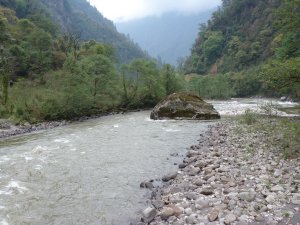IUCN/SSC Otter Specialist Group Bulletin

|
©IUCN/SCC Otter Specialist Group Volume 31 Issue 2 (October 2014) Citation: Medhi, K., Chakraborty, R. and Upadhyay, J. (2014). Photographic Record of Smooth-Coated Otter (Lutrogale perspicillata Geoffroy 1826) in Nyamjang Chu Valley, Arunachal Pradesh, India . IUCN Otter Spec. Group Bull. 31 (2): 75 - 79 Photographic Record of Smooth-Coated Otter (Lutrogale perspicillata Geoffroy 1826) in Nyamjang Chu Valley, Arunachal Pradesh, India Kamal Medhi1, Rajarshi Chakraborty1* and Jaya Upadhyay1
1WWF-India Western Arunachal Landscape Programme, Parvati Nagar, Tezpur, PIN-784001,Assam, India.
|
   |
| Received 17th May 2014, accepted 1st August 2014 |
| Abstract: A pair of Smooth-coated otters was sighted in remote temperate parts of the Nyamjang Chu valley (Chu = River) in westernmost part of Tawang district, Arunachal Pradesh on 1st April 2014. The otters were photographed basking on a riverside rock and identified based on their morphological features. There were no previously published records of Smooth-coated Otters; normally a species found more in plains, from western Arunachal Pradesh and the state as a whole has very scanty information regarding presence and distribution of otters. The sighting signifies the rich biodiversity of Nyamjang Chu, in Pangchen valley and implies initiation of strong conservation measures to safeguard the future of the otters. |
| Keywords: Otters, Nyamjang Chu, Pangchen valley, mountain river, Arunachal Pradesh |
| Française | Español |
INTRODUCTION
Smooth-coated otters, classified as Vulnerable by IUCN (Hussain et al., 2008), is one of the least studied Asian otter species (Hussain and Choudhury, 1997). It is widely distributed in south and south-east Asia, including Pakistan, India, Nepal, Bhutan, Bangladesh, South West China, Myanmar, Thailand, Vietnam, Malaysia, Sumatra, Java and Borneo (Masan and Macdonald, 1986, Corbet and Hill, 1992). In India, it is essentially a plains otter which uses large rivers and lakes, peat swamp forests, mangroves and estuaries (Hussain et al., 2008).
Information regarding its presence and distribution in north-east of India is very scanty, including in Arunachal Pradesh. Although otter species have been reported from various parts of Arunachal Pradesh like Dibang Wildlife Sanctuary in the east (Chetry and Medhi, 2006), Ziro valley (Selvan et al., 2013), in Namdapha Tiger Reserve (Naniwadekar et al., 2013) the identity of the species remains unconfirmed in many occasions and there are no photographic records of Smooth-coated otters from most areas in Arunachal Pradesh. The only published information from Nyamjang Chu valley, the present sighting location, is by Mishra et al. (2006), where they report the presence of otters in upper Nyamjang Chu Valley through secondary information. The present sighting was obtained on 1st April, 2014 in upper Nyamjang Chu and provides the first confirmed record of the species from the region.
DETAILS OF SIGHTING
Arunachal Pradesh, by virtue of its geographical position, climatic conditions and altitudinal variations, is a biodiversity rich region in north-east India, with large tracts of tropical wet evergreen, subtropical, temperate and alpine forests (Paul et al., 2005). The state is a part of the Eastern Himalaya Global Biodiversity Hotspot (Myers et al., 2000) and recognized as one of 200 globally important eco-regions (Olson and Dinerstein 1998). Nyamjang-Chu is one of the two major rivers in the Tawang district in the western most corner of Arunachal Pradesh. Tawang district, with a geographical area of 2085 km2, is entirely mountainous with precipitous terrain and has a population density of 15 per km2 (Tawang district website: http://tawang.nic.in/). The present sighting occurred in the upper Nyamjang Chu valley, between the major settlement of Zemithang (located around 90 km from the town of Tawang, the district headquarters of Tawang district) and Bap Teng Kang (Fig. 1), near the Tawang-Zemithang road
 |
| Figure 1. The sighting location in Tawang district with the two CCAs also marked. Map: Kamal Medhi/ WWF-India. (Click for larger version) |
On 1st April 2014, at around 9:45 am, a pair of otters was sighted on the riverside by the Tawang- Zemithang road, around 15 km away from Zemithang town, between boundaries of two adjoining Community Conserved Areas (CCAs). Pangchen Lumpo Muchat Community Conserved Area (PLUMCCA) and Pangchen Lakhar Community Conserved Area (PLACCA), in two sides of the valley, have been demarcated by the community members with support and guidance from WWF-India. The otters were seen basking on a flat rock near the water’s edge, approx 10 meters from the road, (Fig. 2), at around 2100 m above sea level (asl), the general habitat being lower temperate mixed forests with Pinus sp., Alnus sp., etc. The pair was photographed using multiple hand-held cameras (Sony HX 300) and later on identified by their large heavily webbed front paws, flattened tail, smooth coat, non-spotted muzzle and hairless rhinarium (Pocock, 1941; Prater, 1971; Hussain, 1999). After sometime, one of the animals went down into the water and swam to a nearby patch with large boulders, followed by its companion shortly afterwards. There were earlier infrequent reports of otter sightings by the locals residing in Zemithang and adjoining villages, but the present sighting provides the confirmation regarding the identity.
 |
| Figure 2. The Smooth-Coated Otter pair sighted in Nyamjang Chu in Pangchen valley on 1st April 2014. Pic: Rajarshi Chakraborty/ WWF-India. (Click for larger version) |
DISCUSSION
As mentioned previously, extensive and authentic information on presence and distribution of smooth coated otters in Arunachal Pradesh, the largest of the North-Eastern states of India is lacking. The present record, in the western-most parts of the state, indicates presence of populations with possible trans-boundary distributions with both Bhutan and China. Elevationwise also, the present sighting provides one of the highest records of smooth-coated otters in India (2100 m). In Nepal, smooth-coated otters have been reported at 1500 meters above mean sea level (Shrestha, 1997), lower than the present sighting location. Otters serve as effective symbol of environmental quality and are endorsed as wetland ambassadors to promote the conservation of freshwater biomes (Foster-Turley, 1992; Sivasothi, 1995). In India, they face major threats from habitat destruction due to construction of large-scale hydroelectric projects, reclamation of wetlands for settlement & agriculture, reduction in prey biomass, poaching and contamination of waterways (Hussain et al., 2008). Nyamjang Chu valley, in one of the remotest corners of Arunachal Pradesh, holds a treasure trove of biodiversity including the Red panda (Ailurus fulgens Cuvier), the wintering Black-necked crane (Grus nigricollis Przevalski), Common leopard (Panthera pardus Linneaus) and many rare species of medicinal and aromatic plants (WWF-India unpublished report). The CCAs in Pangchen valley were demarcated with the principal aim to conserve this rich biodiversity. So far, the remoteness of the area has prevented any large scale destructive development but the same can’t be said with the certainty for the future. There are plans for multiple hydro-electric projects across Tawang district and therefore all precautions should be taken to ensure long-term survival of otters in the landscape. Many important habitats of Smooth-coated Otters in India have been lost to developmental activities (Hussain et al, 2008), therefore all efforts should be taken to prevent Nyamjang Chu and habitat around it from having the similar developmental activities (Figure 3). An immediate assessment survey in the sighting location and adjoining stretches of the river is hereby recommended to gather robust information on the distribution of Smooth-coated Otters in the valley and to subsequently formulate conservation strategies.
 |
| Figure 3. The otter habitat in Nyimjang Chu valley. Picture: Jaya Upadhyay/ WWF-India. (Click for larger version) |
Acknowledgements - The authors wish to thank Dr. Dipankar Ghose, Director, Species and Landscape Division, WWF-India, for his continued support and encouragement in the ongoing work. We also thank Dr. Kashmira Kakati and Dr. Asghar Nawab for their valuable inputs regarding identification of the species and encouragement to write this short-note. Finally, we express our gratitude to the inhabitants around Nyamjang Chu for their co-operation and conservation friendly efforts.
REFERENCES
Chetry, D., Medhi, R. (2006). Primate survey in Dibang Wildlife Sanctuary in Arunachal Pradesh, India and its conservation perspectives. Project report submitted to Rufford Small Grants Foundation. Aaranyak. Guwahati.
Corbet, G.B., Hill, J.E. (1992). The mammals of the Indomalayan region, a systematic review. Oxford University Press. Oxford.
Foster-Turley, P. (1992). Conservation ecology of sympatric Asian otter Aonyx cinerea and Lutra perspicillata. PhD thesis, University of Florida.
Hussain, S.A. (1999). Otter conservation in India. ENVIS Bulletin - Wildlife and Protected Areas 2: 92-97.
Hussain, S.A., Choudhury, B.C. (1997). Distribution and status of the Smooth-Coated Otter Lutra perspicilliata in National Chambal Sanctuary, India. Biol. Cons. 80: 199-206.
Hussain, S.A., de Silva, P.K., Mostafa Feeroz, M. (2008). Lutrogale perspicillata. In: IUCN (2013). IUCN Red List of Threatened Species. Version 2013.2. <http://www.iucnredlist.org/>. Downloaded on 21 April 2014.
Mason, C.F., Macdonald, S.M. (1986). Otters: ecology & conservation. Cambridge University Press. London
Mishra, C., Madhusudan, M.D., Datta, A. (2006). Mammals of the high altitudes of western Arunachal Pradesh, eastern Himalaya: an assessment of threats and conservation needs. Oryx 40: 1-7.
Myers, N., Mittermeier, R.A., Mittermeier, C.A., da Fonseca, G.A.B., Oliveri, S. (2000). Biodiversity hotspots for conservation priorities. Nature 403: 853-858.
Naniwadekar, R., Shukla, U., Viswanathan, A., Datta, A. (2013). Records of small carnivores from in and around Namdapha Tiger Reserve, Arunachal Pradesh, India. Small Carniv. Cons.49: 1-8.
Olson, D. M., Dinerstein, E. (1998). The global 200: A representation approach to conserving the earth’s most biologically valuable ecoregions. Cons. Biol.12: 502-515.
Paul, A., Khan, M.L., Arunachalam, A., Arunachalam, K. (2005). Biodiversity and conservation of rhododendrons in Arunachal Pradesh in the Indo-Burma biodiversity hotspot. Curr. Sci. India 89: 623-634.
Pocock, R.I. (1941). The fauna of British India, including Ceylon and Burma. Mammalia. Volume 2. Taylor and Francis. London.
Prater, S.H. (1971). The Book of Indian Animals. Bombay Natural History Society. Bombay.
Selvan, K,M., Veeraswami, G.G., Habib, B., Lyngdoh, S. (2013). Losing threatened and rare wildlife to hunting in Ziro Valley, Arunachal Pradesh, India. Curr. Sci. India 104: 1492-1495.
Sivasothi, N. (1995). The status of otters (Carnivora: Mustelidae: Lutrinae) in Singapore and Malaysia, and the diet of Smooth-Coated Otter Lutrogale perspicillata in Penang, west Malaysia. MSc. Thesis. National University of Singapore.
Shrestha, T.K. (1997). Mammals of Nepal-with reference to those of India, Bangladesh, Bhutan and Pakistan. Mandela Book. Point, Nepal.
Résumé : Preuve Photographique de la Presence de Loutres à Pelage Lisse (Lutrogale Perspicillata Geoffroy 1826) dans la Vallee du Nyamjang Chu, Arunachal Pradesh, Inde
Le 1ier Avril 2014, une paire de Loutre à pelage lisse a été aperçue dans les régions retirées et tempérées de la vallée du Nyamjang Chu (Chu = Rivière) dans la partie la plus à l’Ouest de la région de Tawang, Arunachal Pradesh. Les Loutres ont été photographiées lézardant sur un rocher au bord de la rivière, et leur identification fut basée sur leurs caractéristiques morphologiques. Aucun rapport mentionnant la présence Loutres à pelage lisse n’a encore été publié: normalement cette espèce est principalement trouvée dans les plaines de l’Ouest de Arunachal Pradesh et dans l’ensemble de l’état où les informations relatant leur présence et répartition sont sporadiques. Cette observation révèle la richesse de la biodiversité du Nyamjang Chu dans la vallée de Pangchen et implique l’initiation de fortes mesures de préservation afin de protéger l’avenir de ces Loutres.
Revenez au dessus
Resumen: Registro Fotográfico de la Nutria Lisa (Lutrogale Perspicillata Geoffroy 1826) en el Valle del Rio Nyamjang, Arunachal Pradesh, India
Avistamos una pareja de lutrias lisas en un área remota de clima templado, del valle del río Nyamjang en la parte más occidental del distrito de Tawang, Arunachal Pradesh, el 1° de Abril de 2014. Las nutrias fueron fotografiadas asoleándose en una roca de la orilla del río, y fueron identificadas en base a sus rasgos morfológicos. No había hasta ahora registros publicados de la nutria lisa en Arunachal Pradesh occidental; ésta es normalmente una especie encontrada más en llanuras, y hay muy poca información sobre la presencia y distribución de nutrias en todo el estado. Este avistaje valoriza la rica biodiversidad del río Nyamjang y el Valle Pangchen, e implica el inicio de fuertes medidas de conservación para salvaguardar el futuro de las nutrias.
Vuelva a la tapa